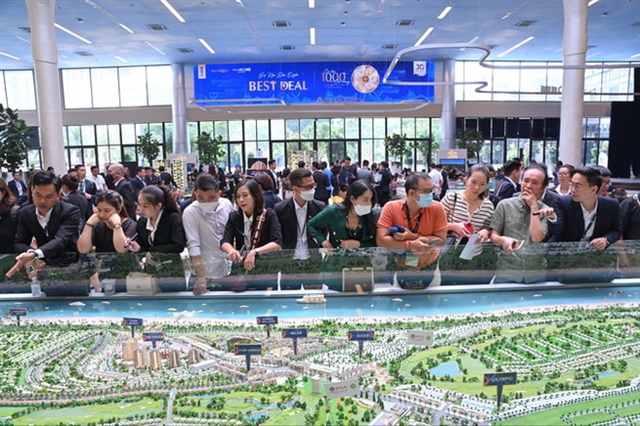 Economy
Economy

As one of Việt Nam’s export mainstays, the fashion and textile sector has been hard hit by COVID-19. Việt Nam News asked RMIT University researchers Associate Professor Rajkishore Nayak (School of Communication & Design) and Dr Majo George (School of Business & Management) for their views on how the sector can prepare to rebound in a post-pandemic world

|
| Associate Professor Rajkishore Nayak (left) and Dr Majo George. — Photo courtesy of RMIT |
As one of Việt Nam’s export mainstays, the fashion and textile sector has been hard hit by COVID-19. Việt Nam News asked RMIT University researchers Associate Professor Rajkishore Nayak (School of Communication & Design) and Dr Majo George (School of Business & Management), who are co-authors of the book Supply Chain Management and Logistics in the Global Fashion Sector: The Sustainability Challenge published in late 2020, for their views on how the sector can prepare to rebound in a post-pandemic world
How has the global supply chain for fashion and textiles been impacted by COVID-19?
Associate Professor Nayak: The pandemic has brought unprecedented challenges for many industries including fashion and textiles. As this sector is highly dependent on the globally integrated supply chain, it has faced significant disruptions.
Take Europe as an example, the manufacturing of clothing here dropped by 37.4 per cent during April-September 2020 compared to the same period in 2019. Meanwhile, the drop in retail sales was an astounding 43.5 per cent during this period.
The global data for fashion and textile imports by the US and European Union (EU), the two major export destinations for fashion and textiles of Viet Nam, have shown a cancellation of orders worth US$16.2 billion during April-June 2020. Many global retailers and garment manufacturers have either downsized or completely ceased their operations due to a substantial reduction in demand.
How are the Vietnamese fashion and textile industries coping with such changes?
Dr George: They have shown good resilience during the COVID-19 outbreak until now. Although many orders from the US, EU and other countries were cancelled during the outbreak of COVID-19 in 2020, the local manufacturers have diversified their product lines to other products such as non-woven facemasks, antibacterial facemasks, and protective clothing for healthcare workers including high-tech personal protective equipment (PPE).
In addition, Vietnamese fashion industries have been better prepared to deliver export orders compared to their counterparts in Cambodia, Myanmar, India, and Indonesia, where COVID-19 control measures are not as strong.
The major challenge that needs to be addressed in the Vietnamese fashion supply chain is how to receive enough orders from the major importing countries in the US and EU. As such, there has not been a substantial increase in the orders in the last quarter of 2020 and early 2021 due to continued lockdown in some parts of the EU and the US in addition to the changing lifestyle of consumers working from home.
How can the local fashion and textile sector come back stronger in the future?
Associate Professor Nayak: Some of the key solutions include Government support such as easing the trade barriers with importing countries, and reduced interest rates and financial support.
For example, the EU-Viet Nam Free Trade Agreement (EVFTA) is helping to increase trade between Viet Nam and the EU. Similarly, the Regional Comprehensive Economic Partnership (RCEP) is opening new export opportunities such as with Japan, China and India, saving costs, and making the supply chain process more flexible. FTAs with other countries can help the Vietnamese fashion and textile industries attract new global brands.
Meanwhile, reduced interest rates and financial support by the government towards automation and technical upgrades can help the industries implement modern technologies that improve productivity, efficiency, and overall product quality. Further, the industries can be in a better place to meet the environmental standards set by the importing countries and also invest in diversified product lines as per the global requirements.
Dr George: The demand in Europe and the US has still not gone up to expected levels due to the continued closure of retail business in some parts. To address this short-term issue, the fashion and textile industries should find new markets for existing products, in addition to exploiting the local demand. Further, they should also diversify their product lines to include emerging products that are in global demand such as facial masks, loungewear, and leisurewear.
In the long term, the focus should be on sustainable development, advanced technologies and automation. Other areas that need to be considered include strengthening the operational capacities, bridging the gap in infrastructure, enhancing the skillset of the labour force, and enhancing the export image of the country as a destination for fashion and textiles.
A lesson can be learnt from Bangladesh, which has shown resilience in overcoming the impact of COVID-19. Many fabric industries in Bangladesh have modernised their manufacturing methods to become self-reliant. This is a major chink in the armour of Viet Nam’s fashion and textile industries. They should prioritise upgrading the fabric manufacturing industries with the latest technology so that Viet Nam can become self-reliant in these production inputs.
Who are the stakeholders that need to take part and how can they work together?
Associate Professor Nayak: The fashion and textile industries should prepare themselves to overcome all the hurdles post-pandemic. The manufacturers should operate closely with the buyers to understand and fulfil the shifting market demand using various digital platforms.
All the retailers operating in local or global markets will focus on omnichannel operations, where e-commerce complements the physical retail stores. There was an increased use of online platforms by customers in many countries including Viet Nam in 2020 due to social distancing and lockdowns. This trend has continued in the first quarter of 2021 and will be the future trend even when life comes back to normal. Hence, the manufacturers and retailers should use omnichannels for their retail distribution (physical as well as online selling).
For retailers, another major focus will be to thoroughly understand the market demand and avoid the problem of excess inventory. They should source the products that are in demand close to the season. The sourcing should be done in small quantities and especially from suppliers closer to them.
Dr George: The manufacturers, on the other hand, should focus on manufacturing the products with global demand, upgrading their technology, making sustainable products, and using digital platforms. Waste reduction will be also a major focus of the manufacturers by using the concepts of lean and agile manufacturing to save costs.
The relationship between the buyers and suppliers needs to be strengthened by effective communication so that the consumer demand is fulfilled appropriately. For manufacturers and retailers, this is the time to retrospect, redesign their supply chains, seek the right future products, and invest in the requirements of tomorrow. The short-term and long-term planning will not only help the industries to stay fit post-pandemic but also help them to better prepare themselves to be resilient if similar pandemic-like situations arise in the future. — VNS




